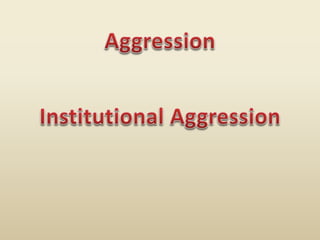
A-Level Psychology: Institutional Aggression - New Spec
- 2. • Institutional Aggression: Aggressive acts that are found in particular ‘violent’ institutions, such as prisons.
- 3. • Situational Explanation: Emphasises that the causes of a particular behaviour (aggression) is due to the context in which it occurs, rather than any characteristics of the individuals involved.
- 4. • The Deprivation Model: This model argues that prisoners act more aggressively in response to their oppressive conditions in the prison – their situation causes their aggression. • Sykes (1958): Described specific deprivations that inmates experience in prisons which may link to increased aggression: – Loss of liberty; – Loss of autonomy; – Loss of security etc. Some may cope with this by secluding themselves in their cell, while others choose to rebel using violence against other inmates or against the guards.
- 5. • For – David Wilson 1990s: Real-world application in HMP Woodhill. Improved the conditions in two units of the prison where typical ‘prison noise’ was reduced, radio played, there was more space, temperatures lowered so less stuffy and there was an outside view. These changes almost eradicated violence from inmates, proving dispositional factors make a difference. • Against – Harer and Steffensmeier 1996: Conducted a meta-analysis from 24,000 inmates in 56 US prisons. Both importation factors (race, criminal history) and deprivation factors (staff-to-prisoner ratio, security levels) were included and they tested which of these predicted the likelihood of aggressive behaviour in individuals. They concluded that age, race and criminal history were the only significant factors and that none of the deprivation variables made a difference.
- 6. • Dispositional Explanation: Emphasises that the causes of a particular behaviour (aggression) are due to the characteristics of the individuals involved, rather than any aspect of the situation they are in.
- 7. • The Importation Model: This model suggests that inmates bring their violent pasts to the prison. They draw from their previous experiences on how to survive in difficult situations and apply these to the prison. – Irwin and Cressey 1962: Prisoners are not ‘blank slates’ when they enter prison. Many ‘systems’ which would have developed in their pasts in the outside world, get imported into the prisons; the ‘code of the streets.’ – Gang membership is constantly related to anti-social behaviour. Drury and DeLisi 2011 – Found that in over 1,000 inmates, members who had been in gangs prior to imprisonment were more likely to commit various types of misconduct in prison.
- 8. • For – Poole and Regoli 1983: Found that the best indicator of violence in juvenile offenders was pre- institutional violence, regardless of any situational factors. • Against – DeLisi et al. 2004: Found that inmates with prior street gang involvement were no more likely to commit crimes than other inmates.